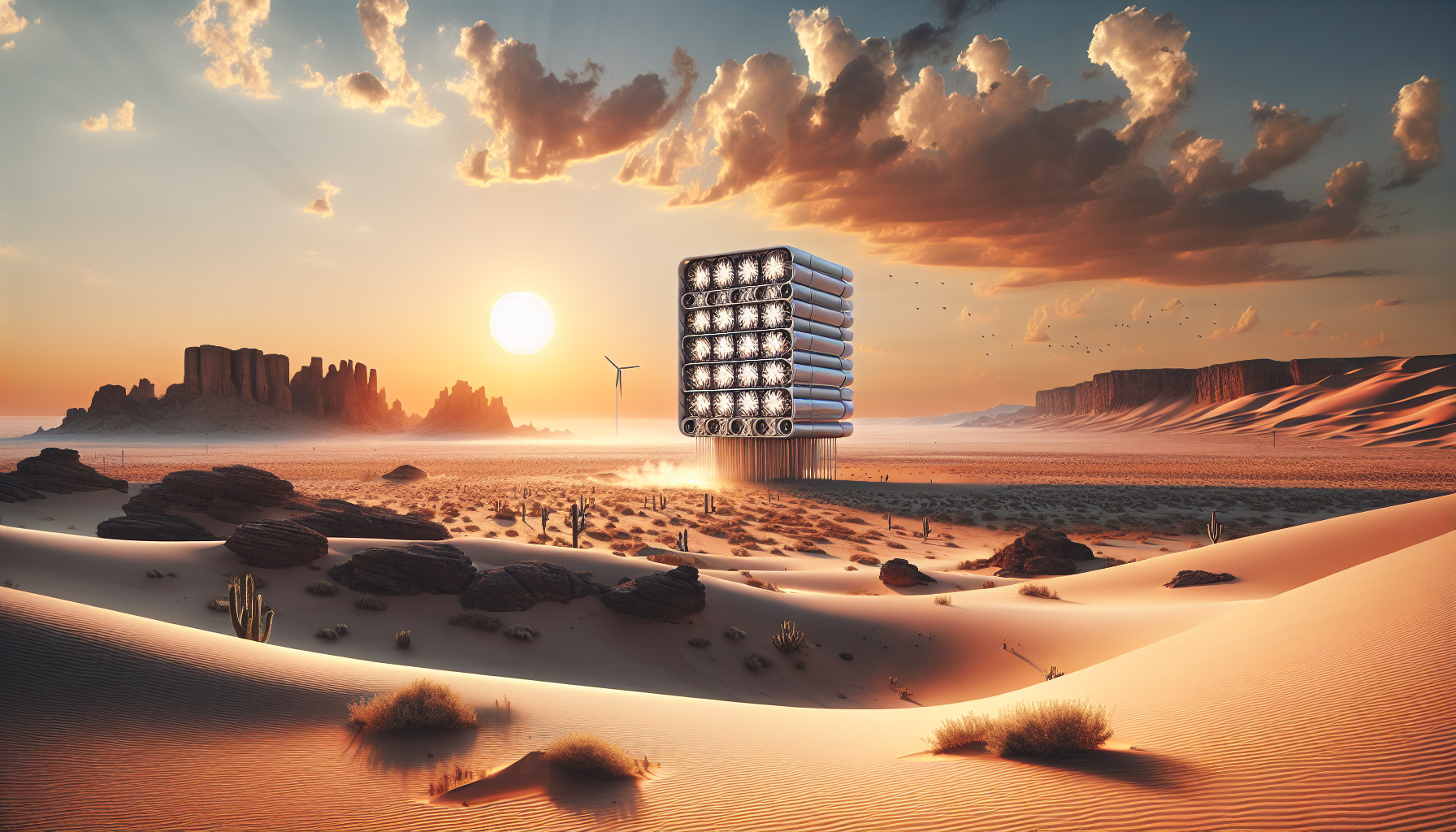In the relentless pursuit of creating comfortable living and working spaces, humanity has often looked towards technology, innovation, and modern engineering. However, as we grapple with the challenges of climate change and seek sustainable solutions, nature itself emerges as a profound source of inspiration. Imagine harnessing the raw, untamed forces of the desert wind to cool and ventilate our buildings, offering not just a reprieve from soaring temperatures, but a breath of fresh air in more ways than one. Welcome to the revolutionary concept of Desert Airflow Ventilation—a natural, eco-friendly approach to achieving cooler, fresher environments.
At first glance, the desert might seem like an unlikely ally in the quest for cooling solutions. Characterized by extreme temperatures and arid landscapes, it is a place where survival often seems like a battle against the elements. Yet, it is precisely within these harsh conditions that nature showcases some of its most ingenious adaptations. The concept of Desert Airflow Ventilation draws inspiration from these natural phenomena, leveraging the power of airflow and thermal dynamics to create a sustainable cooling system. By understanding and imitating the natural processes of the desert, we can transform our approach to ventilation and energy efficiency in buildings.
This innovative approach revolves around the principle of passive cooling, a method that eschews energy-intensive air conditioning systems in favor of natural airflow and temperature regulation. The science behind it is as fascinating as it is effective—by strategically designing structures to facilitate the flow of air, it is possible to harness the cooler night breezes and the shade provided by architectural elements, thereby reducing the reliance on artificial cooling. This not only translates into substantial energy savings but also significantly lowers the carbon footprint of buildings, aligning perfectly with the growing global emphasis on sustainability and environmental responsibility.
As we delve deeper into the world of Desert Airflow Ventilation, this article will explore the intricate balance between architecture and nature, examining case studies of buildings that have successfully implemented these principles. We will discuss the innovative design elements that make it possible to capture and channel airflow, the materials that enhance these processes, and the technological advancements that support this paradigm shift. Furthermore, we’ll look at the broader implications of adopting such sustainable practices, including economic benefits, improved indoor air quality, and the potential to reshape urban landscapes in harmony with the natural environment.
By the end of this exploration, you will not only gain a deeper understanding of how Desert Airflow Ventilation works but also appreciate its potential to revolutionize the way we think about cooling and ventilation. Join us on this journey as we unleash the power of nature, drawing from the wisdom of the desert to create a future where our built environments are as dynamic and resilient as the natural world itself. 🌿
Understanding Desert Airflow Ventilation: A Comprehensive Overview
Desert airflow ventilation is an innovative approach to cooling and maintaining fresh environments, particularly in arid regions where traditional air conditioning systems often fall short. This method leverages the natural properties of airflow and the desert climate to provide a sustainable and efficient alternative to conventional cooling systems. As climate change continues to impact global temperatures, exploring nature-based solutions like desert airflow ventilation becomes increasingly critical. This article delves deep into the principles behind this technology, its benefits, and its practical applications.
One of the primary aspects of desert airflow ventilation is its reliance on natural air movement. In desert regions, the significant temperature differences between day and night create natural convection currents. During the day, the sun heats the air, causing it to rise and be replaced by cooler air from below. At night, the process reverses, with cooler air descending. This natural cycle can be harnessed to improve ventilation and maintain comfortable indoor temperatures without excessive energy use.
Moreover, desert airflow ventilation systems often incorporate elements like wind towers and passive cooling techniques. Wind towers, for instance, are traditional architectural features used in Middle Eastern and North African countries. They capture and direct wind into buildings, creating a cooling effect through increased air circulation. Passive cooling, on the other hand, involves designing buildings to optimize natural shade and airflow, reducing the need for artificial cooling. Together, these techniques offer a compelling, eco-friendly alternative to conventional air conditioning systems.
Benefits of Desert Airflow Ventilation
The adoption of desert airflow ventilation offers numerous benefits, particularly in terms of sustainability and cost efficiency. By reducing reliance on mechanical cooling systems, this approach significantly lowers energy consumption and, consequently, greenhouse gas emissions. This not only contributes to environmental conservation but also results in considerable cost savings for households and businesses. Furthermore, the reduced energy demand helps mitigate the impact of energy shortages, a common issue in many desert regions.
Another major advantage of desert airflow ventilation is its ability to improve indoor air quality. Traditional air conditioning systems often recirculate indoor air, which can lead to the buildup of pollutants and allergens. In contrast, natural ventilation systems ensure a constant supply of fresh air, enhancing indoor air quality and promoting better health for occupants. This is particularly important in desert regions, where dust and pollutants can be significant concerns.
Moreover, desert airflow ventilation systems are generally low maintenance, reducing long-term operational costs. Unlike conventional air conditioners, which require regular servicing and repairs, natural ventilation systems have fewer mechanical components and are thus less prone to breakdowns. This makes them an ideal solution for remote or underdeveloped areas where access to maintenance services may be limited.
Implementing Desert Airflow Ventilation in Modern Architecture
Integrating desert airflow ventilation into modern architecture involves a blend of traditional techniques and contemporary design innovations. Architects and builders must carefully consider factors such as building orientation, material selection, and structural design to optimize natural airflow. For instance, strategically placed openings and corridors can facilitate cross-ventilation, while materials with high thermal mass can absorb and release heat, stabilizing indoor temperatures.
Additionally, incorporating vegetation into building design can enhance the effectiveness of natural ventilation. Plants not only provide shade but also release moisture through transpiration, further cooling the air. This is especially effective in desert environments, where evaporative cooling can be a significant asset. Rooftop gardens, green walls, and courtyard designs are all viable options for integrating vegetation into modern buildings.
The implementation of these strategies requires a multidisciplinary approach, involving architects, engineers, and environmental scientists. Collaboration among these professionals ensures that buildings are designed to maximize the benefits of desert airflow ventilation while meeting the needs of occupants. As urbanization continues to expand into arid regions, the demand for sustainable and efficient cooling solutions like desert airflow ventilation will only grow.
Table: Comparing Traditional Air Conditioning and Desert Airflow Ventilation
| Aspect | Traditional Air Conditioning | Desert Airflow Ventilation |
|---|---|---|
| Energy Consumption | High | Low |
| Environmental Impact | Significant greenhouse gas emissions | Minimal emissions |
| Maintenance Requirements | Frequent | Infrequent |
| Indoor Air Quality | Can recirculate pollutants | Improved air quality with fresh air flow |
| Cost Efficiency | Higher operational costs | Cost-effective in the long term |
Check out the table above to see a detailed comparison between traditional air conditioning and desert airflow ventilation.
Case Studies: Success Stories of Desert Airflow Ventilation
Several projects around the world have successfully implemented desert airflow ventilation, demonstrating its viability and effectiveness. One notable example is the Masdar City project in the United Arab Emirates. Designed to be a model for sustainable urban development, Masdar City incorporates numerous eco-friendly technologies, including wind towers and passive cooling systems. These features have helped the city maintain comfortable temperatures with minimal energy consumption, setting a benchmark for sustainable urban living.
Another inspiring case is the School of the Desert in Rajasthan, India. This educational institution utilizes traditional architectural techniques combined with modern technology to create a comfortable learning environment in one of the world’s hottest regions. By using thick walls, high ceilings, and strategically placed windows, the school maximizes natural airflow and minimizes heat gain. The result is a cool, inviting space that supports student well-being and academic performance.
Furthermore, the development of eco-resorts in desert regions has highlighted the potential of desert airflow ventilation in the hospitality industry. Resorts like the Six Senses in Jordan’s Wadi Rum desert have embraced natural cooling techniques to create luxurious yet sustainable accommodations. By integrating the principles of desert airflow ventilation, these resorts offer guests a comfortable stay while minimizing environmental impact, proving that luxury and sustainability can coexist.
Watch and Learn: Desert Airflow Ventilation in Action
For a visual understanding of how desert airflow ventilation works, watch this insightful video on YouTube: Desert Ventilation Techniques by EcoArchitecture Channel. This video provides an excellent overview of the principles and applications of this innovative cooling solution.
The Future of Desert Airflow Ventilation
As the world continues to grapple with the challenges of climate change and resource scarcity, the importance of sustainable technologies like desert airflow ventilation cannot be overstated. With advancements in materials science and architectural design, the potential for improving and expanding the use of natural ventilation systems is vast. Emerging technologies, such as smart ventilation systems that adapt to changing environmental conditions, offer exciting possibilities for enhancing the efficiency of desert airflow ventilation.
Moreover, the integration of renewable energy sources, such as solar and wind power, can further boost the sustainability of these systems. By harnessing the abundant sunlight and wind in desert regions, buildings can generate clean energy to complement their natural ventilation strategies, achieving even greater energy independence and environmental benefits.
In conclusion, desert airflow ventilation represents a promising path forward for creating comfortable, sustainable environments in arid regions. As more architects and developers embrace this approach, the potential for transforming urban landscapes and improving quality of life in desert areas is immense. Whether through new construction or retrofitting existing buildings, the adoption of desert airflow ventilation is a crucial step toward a more sustainable future.

Conclusion
Certainly! Here is a conclusion for your article on “Unleash the Power of Nature: Desert Airflow Ventilation for Cool, Fresh Environments”:
—
As we draw this discussion to a close, it’s clear that the ancient wisdom of using desert airflow ventilation is more relevant today than ever before. This innovative approach, which harnesses natural forces to maintain cooler and fresher environments, stands as a testament to human ingenuity and nature’s generosity. Throughout this article, we have explored how this system can transform living and working spaces, offering a sustainable alternative to energy-intensive cooling methods.
To recap, we began by understanding the basic principles of desert airflow ventilation. This method utilizes the natural cooling effects of wind and evaporation to create a comfortable indoor climate. By allowing air to flow through strategically placed vents and ducts, it reduces reliance on artificial air conditioning systems. This not only cuts down on electricity costs but also significantly reduces carbon emissions, making it an environmentally friendly choice.
We delved into the science behind airflow patterns and how they can be optimized to maximize cooling efficiency. The strategic placement of vents and openings in buildings is crucial for harnessing the full potential of natural ventilation. Furthermore, we examined various case studies that highlighted the successful implementation of these systems in different architectural designs, demonstrating their versatility and adaptability.
Moreover, the cultural and historical context of desert ventilation systems provided a rich tapestry of knowledge. Civilizations across the world, from the Middle Eastern regions to parts of North Africa, have long embraced these techniques. Their architectural marvels, like the iconic windcatchers of Iran, serve as enduring symbols of how traditional wisdom can solve modern challenges.
The importance of adopting such sustainable practices cannot be overstated. With the growing concerns about climate change and the urgent need to reduce our carbon footprint, embracing natural ventilation solutions offers a viable path forward. It is a call to action for architects, builders, and homeowners alike to integrate these systems into their designs.
As you reflect on the insights shared in this article, consider how you can implement these strategies in your own environment. Whether you are planning a new construction project or looking to retrofit an existing space, the principles of desert airflow ventilation can be tailored to suit your needs. By doing so, you contribute to a more sustainable future, where innovation and nature work hand in hand.
We encourage you to engage with this topic further. Share your thoughts and experiences in the comments section below. How have you or your community benefited from natural ventilation systems? What challenges have you faced, and what solutions have you discovered? By sharing your story, you can inspire others to consider the potential of nature-driven solutions in their own lives.
Feel free to share this article with friends, colleagues, or anyone who might benefit from this information. By spreading awareness, you play a pivotal role in promoting sustainable living practices. Remember, each small step towards sustainability contributes to a larger impact on our planet’s health.
For those interested in exploring this topic further, numerous resources are available online. Websites like the U.S. Department of Energy’s Energy Saver provide valuable insights into energy-efficient building practices. Additionally, the International Energy Agency offers comprehensive reports on global energy trends and sustainable solutions.
In conclusion, embracing the power of nature through desert airflow ventilation is not just a nod to the past, but a vital step toward a sustainable future. It invites us to rethink how we interact with our environment, urging us to prioritize solutions that are both innovative and respectful of the natural world. Let us seize this opportunity to harness nature’s wisdom and create spaces that are not only cool and fresh but also kind to our planet.
🌿
—
This conclusion wraps up the article by summarizing the key points, emphasizing the importance of the topic, and encouraging reader interaction and application.
Toni Santos is a visual storyteller and educational ethnographer whose work celebrates the fluid knowledge systems of nomadic cultures. Through art and research, Toni brings attention to how learning has thrived outside traditional institutions—rooted in movement, oral tradition, and deep connection to land and community.
Guided by a passion for ancestral wisdom, adaptive pedagogy, and cultural resilience, Toni explores the tools, rituals, and environments that once shaped the minds of travelers, herders, and migrating communities. Whether illustrating storytelling circles beneath open skies, wearable mnemonic devices, or maps woven into textiles, Toni’s work honors learning as a lived, sensory, and communal experience.
With a background in visual anthropology and intercultural design, Toni reconstructs the educational models of mobile societies through images and narratives that restore their dignity and relevance in today’s world.
As the creative mind behind Vizovex, Toni shares a rich tapestry of visual essays, artifact-inspired art, and curated stories that reveal the genius of teaching and learning on the move.
His work is a tribute to:
The wisdom of learning through journey, rhythm, and story
The spatial and environmental intelligence of nomadic cultures
The power of intergenerational knowledge passed outside walls
Whether you’re an educator, researcher, or lifelong learner, Toni invites you to step into a world where education is not confined, but carried—one step, one song, one shared insight at a time.





